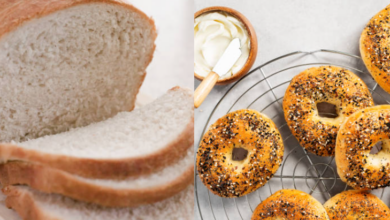The Surprising Reason Why White Bread Is Processed: Find Out Why
What To Know
- The removal of the bran and germ not only alters the nutritional profile but also imparts a lighter color and texture to the bread.
- This involves exposing it to chemical agents, such as chlorine dioxide or benzoyl peroxide, which oxidize the pigments in the flour, resulting in a brighter, more uniform appearance.
- While it results in a visually appealing, soft, and longer-lasting product, it also comes at the expense of nutritional value and potential health concerns.
In the realm of baked goods, white bread stands as a staple, enjoyed by countless individuals worldwide. However, beneath its seemingly innocuous exterior lies a complex process that raises the question: “Why is white bread processed?” This blog post delves into the intricacies of white bread production, exploring the reasons behind its processed nature and the consequences it entails.
The Milling Process: Refining the Grains
The journey of white bread begins with wheat grains, which are meticulously milled to remove the bran and germ, leaving behind the starchy endosperm. This process, known as white flour milling, results in a highly refined flour that lacks the fiber and nutrients found in whole-wheat flour. The removal of the bran and germ not only alters the nutritional profile but also imparts a lighter color and texture to the bread.
Bleaching: Achieving Desired Whiteness
To achieve the characteristic white color of white bread, flour undergoes a bleaching process. This involves exposing it to chemical agents, such as chlorine dioxide or benzoyl peroxide, which oxidize the pigments in the flour, resulting in a brighter, more uniform appearance. Bleaching serves not only aesthetic purposes but also strengthens the gluten network, improving the bread’s structure and texture.
Enrichment: Compensating for Nutritional Losses
Despite the removal of the bran and germ, white bread is typically enriched with essential vitamins and minerals, such as thiamin, niacin, and iron. This process aims to compensate for the nutrients lost during milling and ensure that the bread meets government-mandated nutritional standards. Enrichment helps to maintain the nutritional value of white bread, albeit to a lesser extent than that of whole-wheat bread.
Preservatives: Extending Shelf Life
To extend the shelf life of white bread, preservatives are often added. These substances, such as calcium propionate or sodium benzoate, inhibit the growth of mold and bacteria, preventing spoilage and ensuring a longer shelf life. The use of preservatives allows white bread to remain fresh for several days, making it a convenient option for consumers.
Emulsifiers: Enhancing Texture and Structure
Emulsifiers are another type of additive commonly used in white bread. These substances, such as monoglycerides or diglycerides, help to improve the texture and structure of the bread by facilitating the interaction between water and fat. Emulsifiers create a more uniform crumb structure, reduce staling, and enhance the overall mouthfeel of the bread.
Consequences of Processed White Bread
While processing enhances the appearance, texture, and shelf life of white bread, it also comes with certain consequences:
- Reduced Nutritional Value: The removal of bran and germ significantly diminishes the nutritional value of white bread compared to whole-wheat bread. It is lower in fiber, vitamins, and minerals.
- Potential Health Concerns: Refined white flour has been linked to an increased risk of chronic diseases such as type 2 diabetes, heart disease, and obesity due to its high glycemic index.
- Environmental Impact: The cultivation of white flour requires the use of pesticides and fertilizers, contributing to environmental pollution. Additionally, the bleaching process can release harmful chemicals into the environment.
Final Note: Balancing Convenience and Health
The processing of white bread is a complex process driven by factors such as consumer preferences, convenience, and shelf life. While it results in a visually appealing, soft, and longer-lasting product, it also comes at the expense of nutritional value and potential health concerns. Consumers should be aware of the consequences and make informed choices based on their individual dietary needs and preferences.
Common Questions and Answers
Q: Is white bread healthier than whole-wheat bread?
A: Whole-wheat bread is generally considered healthier than white bread due to its higher fiber and nutrient content.
Q: Can I make white bread at home without processing?
A: Yes, it is possible to make white bread at home using unbleached, whole-wheat flour. However, it may not have the same texture or shelf life as processed white bread.
Q: Are there any alternatives to white bread?
A: Yes, there are numerous alternatives to white bread, such as whole-wheat bread, rye bread, sourdough bread, and gluten-free bread. Each option offers its own unique nutritional profile and taste.
